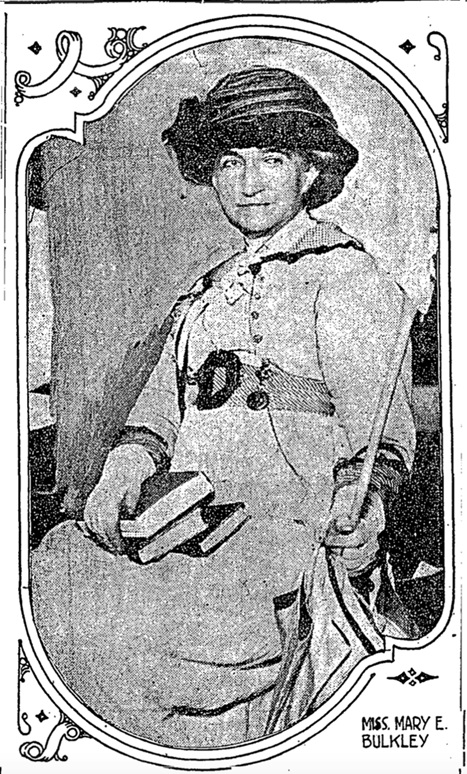Biographical Database of NAWSA Suffragists, 1890-1920
Biography of Mary Ezit Bulkley, 1856–1947
By Brooke Collier, University of Missouri
Chairman of the Industrial Relations Committee of the Central Council of Social Agencies, member of the Neighborhood Association, founding member of the Wednesday Club, member of the St. Louis Equal Suffrage League, treasurer of the Missouri Equal Suffrage Association, and Vice President of the Women's Trade Union League.
Mary Ezit Bulkley was born in New York City on November 12, 1856, to Peter and Mary M. Bulkley. The Bulkleys moved to St. Louis, Missouri, in 1866. After studying bookbinding in Chicago under Ellen Gates Starr in the late 1880s, Mary came back to St. Louis. By 1920, Mary had retired and moved to California where she later died in 1947, at the age of 92.
Mary Bulkley was very active in local suffrage leagues and fighting for women's rights. As a member of the St. Louis Equal Suffrage League, she helped gathered 14,000 signatures from Missouri voters asking for a women's suffrage amendment to go on the ballot in the 1914 election. After sending letters to all the legislators asking them to put the amendment in front of voters, Mary and other members of the League traveled to Jefferson City. Their petition went through the Senate and House committees favorably, but by the end of the General Assembly's session, the amendment had been taken off the agenda. This made the group of women work harder, getting more signatures on petitions, talking to legislators, and getting the word out through major newspapers. They did this for a year and a half, and on November 3, 1914, it went on the ballot with 14 other amendments. They lost the vote to 322,463 “noes” to 182,257 “ayes.” This did not deter Mary from her women's rights advocacy. Instead, by 1915, she had taken on a leadership role at the Missouri Woman, the Missouri Equal Suffrage Association's monthly publication that ran until women were partially enfranchised and the Federal Suffrage Amendment had been ratified in 1920. She often contributed articles of her own that were, “sparked with her wry humor and always provocative in content and tone,” according to In Her Place by Katharine Corbett.
Mary was one of the key women in organizing the suffrage “Walking Parade” in St. Louis at the Democratic Convention on June 14, 1916. Seven thousand omen participated, all wearing white with yellow sashes and carrying yellow parasols. The parade route was 10 blocks and it was the same stretch that the convention delegates had to walk to get to the convention center from their hotel.
Mary wrote about suffrage outside of the Missouri Woman, too. She wrote a play for the Equal Suffrage League titled, “The Trial: What's the Constitution Among Friend?” about Susan B. Anthony's legal battle after she attempted to vote in 1872. She also wrote a booklet called “Aid to the Woman Voter in Missouri.” The Equal Suffrage League sold this booklet as a fundraiser and it was eventually used in voter education. By 1920, the word “woman” was dropped from the title and it became an educational booklet for all Missouri voters.
Sources
Katharine T. Corbett includes a biographical essay of Mary in her book In Her Place: A Guide to St. Louis Women's History (St. Louis, MO: Missouri Historical Society Press, 1999). Much of the biographical material for the essay is from Mary's unpublished autobiography, Grandmother, Mother and Me. A typescript of this work is at the Missouri Historical Society. Mary's work is also documented in the St Louis Post-Dispatch, the Ogden Standard Examiner, and The History of Woman Suffrage.
Images
Image of Miss Mary Bulkley (top). Ogden Standard Examiner. Ogden, Utah, May 12, 1916.

Image of Miss Mary Bulkley. St. Louis Post-Dispatch. July 22, 1915.

